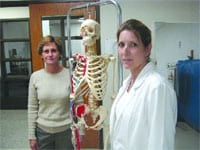Editorial Drug Treatments Should Not Be Based On Ads
This month’s issue of The Healthcare News features a story on a local company developed to help low-income people access free-prescription benefits from drug companies. It’s a unique business model in the area, and one that could take off with enough word of mouth and perhaps media attention.
Issues surrounding prescription drugs, and their costs, are in fact quite common in the media these days. Drug benefits — from the current, controversial Medicare plan to the Bay State’s own three-year-old Prescription Advantage program — have received plenty of attention, as have statistics showing that Americans, and senior citizens in particular, are spending more of their incomes on prescriptions than ever before.
These rising costs are perhaps unavoidable in an era when new, powerful drugs are being developed with blinding speed — like any new technology or innovation, price tags are going to be high. But in another story in The Healthcare News this month, the head of a Springfield-based health plan talks about another reason drug prices have soared so high — and this one, he says, is not quite so acceptable.
“Today, people are bombarded with direct-to-consumer advertising, and I think the worst thing that has happened to medicine is treating these extremely expensive drugs as if they’re just consumer goods that everyone should want,” says Peter Straley, president of Health New England.
He likens the situation to children who see other kids playing with a new toy and insist they should have it, too. It’s a valid comparison, as TV ads for drugs are as glitzy and attractive as those for recreational products.
The problem, Straley says, is that they’re not recreational — they’re medical. And they’re often very powerful, with side effects that differ from patient to patient.
The only solution to reducing the cost impact of direct-to-consumer marketing, many health professionals say, is simply to let doctors be doctors and learn to resist to the invasive advertisements and the patients who are swayed by them.
“Patients are more attuned to prescription drugs because of direct pharmaceutical marketing and the Internet,” Dr. Luis Sanchez and attorney Debra Grossbaum wrote in the Mass. Medical Society (MMS) publication Vital Signs. The pair work for Physician Health Services, a branch of the MMS that helps physicians tackle their own health issues.
“Of course, the drugs patients want may be appropriate,” they wrote. “But it is important to complete an adequate assessment during a short visit or consultation with a persistent patient.”
The risks of excessive or improper prescribing can be significant, Sanchez and Grossbaum say. Overprescribing narcotics can lead to chemical dependence, while overprescribing antibiotics can bolster the resistance of bacteria. And, of course, they cite soaring drug costs as a key issue as well.
Patients sometimes feel like their treatment isn’t complete if they don’t bring home a bottle of pills, experts say, and this is also an environment fostered by today’s marketing campaigns. And many doctors might find it easier to simply write a prescription for pain or other problems instead of questioning the patient’s assessment or working to uncover the source of the problem.
Sanchez and Grossbaum say establishing written office protocols governing prescribing guidelines may help patients better understand the medical rationales for not prescribing certain drugs. Pamphlets on addiction, antibiotic resistance, and other negative effects of overprescribing can also be helpful to patients.
But in the end, physicians must heed a slogan that may be overused but is certainly relevant in today’s doctor’s office. Sometimes, they need to “just say no.” –

